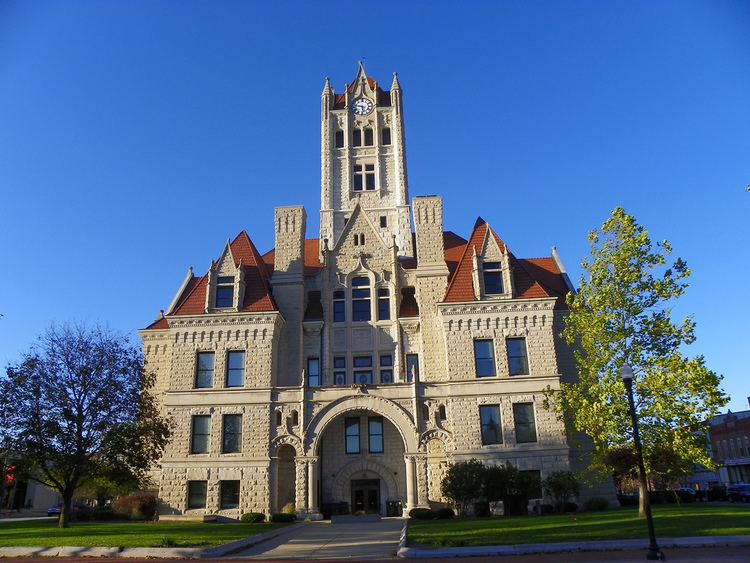Area 795.2 km² Population 71,575 (2013) | Website www.hancockcoingov.org Founded 1828 | |
 | ||
Points of interest Brandywine Park, Riley Park, Fortville Memorial Park, Henry B Wilson Park, Riley Home Museum | ||
Hancock County is a county located in the U.S. state of Indiana. As of 2010, the population was 70,002. The county seat is Greenfield.
Contents
- Map of Hancock County IN USA
- Geography
- Adjacent counties
- Airport
- History
- Climate and weather
- Government
- Demographics
- Cities and towns
- Townships
- References
Map of Hancock County, IN, USA
Hancock County is included in the Indianapolis-Carmel-Anderson, IN Metropolitan Statistical Area
Geography
According to the 2010 census, the county has a total area of 307.02 square miles (795.2 km2), of which 306.02 square miles (792.6 km2) (or 99.67%) is land and 1.01 square miles (2.6 km2) (or 0.33%) is water.
Adjacent counties
Airport
History
Hancock County was officially formed on March 1, 1828. It was named for John Hancock, president of the Continental Congress, who signed his name prominently to the Declaration of Independence.
Climate and weather
In recent years, average temperatures in Greenfield have ranged from a low of 17 °F (−8 °C) in January to a high of 85 °F (29 °C) in July, although a record low of −29 °F (−34 °C) was recorded in January 1985 and a record high of 103 °F (39 °C) was recorded in June 1988. Average monthly precipitation ranged from 2.37 inches (60 mm) in February to 4.85 inches (123 mm) in July.
Government
The county government is a constitutional body, and is granted specific powers by the Constitution of Indiana, and by the Indiana Code.
County Council: The county council is the legislative branch of the county government and controls all the spending and revenue collection in the county. Representatives are elected from county districts. The council members serve four-year terms. They are responsible for setting salaries, the annual budget, and special spending. The council also has limited authority to impose local taxes, in the form of an income and property tax that is subject to state level approval, excise taxes, and service taxes.
Board of Commissioners: The executive body of the county is made of a board of commissioners. The commissioners are elected county-wide, in staggered terms, and each serves a four-year term. One of the commissioners, typically the most senior, serves as president. The commissioners are charged with executing the acts legislated by the council, collecting revenue, and managing the day-to-day functions of the county government.
Court: The county maintains a small claims court that can handle some civil cases. The judge on the court is elected to a term of four years and must be a member of the Indiana Bar Association. The judge is assisted by a constable who is also elected to a four-year term. In some cases, court decisions can be appealed to the state level circuit court.
County Officials: The county has several other elected offices, including sheriff, coroner, auditor, treasurer, recorder, surveyor, and circuit court clerk Each of these elected officers serves a term of four years and oversees a different part of county government. Members elected to county government positions are required to declare party affiliations and to be residents of the county.
Hancock County is part of Indiana's 5th congressional district; Indiana Senate district 28; and Indiana House of Representatives districts 29 and 53.
Demographics
As of the 2010 United States Census, there were 70,002 people, 26,304 households, and 19,792 families residing in the county. The population density was 228.8 inhabitants per square mile (88.3/km2). There were 28,125 housing units at an average density of 91.9 per square mile (35.5/km2). The racial makeup of the county was 95.2% white, 2.1% black or African American, 0.8% Asian, 0.2% American Indian, 0.4% from other races, and 1.2% from two or more races. Those of Hispanic or Latino origin made up 1.7% of the population. In terms of ancestry, 26.2% were German, 13.9% were Irish, 11.8% were English, and 11.8% were American.
Of the 26,304 households, 37.2% had children under the age of 18 living with them, 61.0% were married couples living together, 9.8% had a female householder with no husband present, 24.8% were non-families, and 20.3% of all households were made up of individuals. The average household size was 2.64 and the average family size was 3.03. The median age was 39.1 years.
The median income for a household in the county was $47,697 and the median income for a family was $69,734. Males had a median income of $53,565 versus $38,042 for females. The per capita income for the county was $28,017. About 5.9% of families and 7.3% of the population were below the poverty line, including 8.0% of those under age 18 and 5.2% of those age 65 or over.
